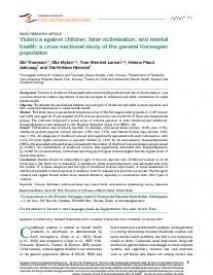Violence against children, later victimisation, and mental health: a cross-sectional study of the general Norwegian population
Background: Violence in childhood is associated with mental health problems and risk of revictimisation. Less
is known about the relative importance of the various types of childhood and adult victimisation for adult
mental health.
Objective: To estimate the associations between various types of childhood and adult violence exposure, and
their combined associations to adult mental health.
Method: This study was a cross-sectional telephone survey of the Norwegian adult population; 2,435 women
and 2,092 men aged 1875 participated (19.3% of those we tried to call and 42.9% of those who answered the
phone). The interview comprised a broad array of violence exposure in both childhood and adulthood.
Anxiety/depression was measured by the Hopkins Symptom Check List (HSCL-10).
Results: Victimisation was commonly reported, for example, child sexual abuse (women: 10.2%, men: 3.5%),
childhoodparental physical violence (women: 4.9%, men: 5.1%), and lifetime forcible rape (women: 9.4%,
men: 1.1%). All categories of childhood violence were significantly associated with adult victimisation, with
a 2.25.0 times higher occurrence in exposed children (pB0.05 for all associations). Anxiety/depression
(HSCL-10) associated with adult abuse increased with the number of childhood violence categories experienced
(pB0.001). All combinations of childhood violence were significantly associated with anxiety/depression
(pB0.001 for all associations). Individuals reporting psychological violence/neglect had the highest levels of
anxiety/depression.
Conclusions: Results should be interpreted in light of the low response rate. Childhood violence in all its
forms was a risk factor for victimisation in adulthood. Adult anxiety/depression was associated with both
the number of violence categories and the type of childhood violence experienced. A broad assessment of
childhood and adult violence exposure is necessary both for research and prevention purposes. Psychological
violence and neglect should receive more research attention, especially in combination with other types of
violence.
Geachte bezoeker,
De informatie die u nu opvraagt, kan door psychotraumanet niet aan u worden getoond. Dit kan verschillende redenen hebben,
waarvan (bescherming van het) auteursrecht de meeste voorkomende is. Wanneer het mogelijk is om u door te verwijzen naar de bron
van deze informatie, dan ziet u hier onder een link naar die plek.
Als er geen link staat, kunt u contact opnemen met de bibliotheek,
die u verder op weg kan helpen.
Met vriendelijke groet,
Het psychotraumanet-team.
Reference:
Siri Thoresen, Mia Myhre, Tore Wentzel-Larsen, Helene Flood Aakvaag, & Ole Kristian Hjemdal | 2015
In: European journal of psychotraumatology, ISSN 2000-8066 | 6 | januari | 26259
http://www.ncbi.nlm.nih.gov/pmc/articles/PMC4296052/
In: European journal of psychotraumatology, ISSN 2000-8066 | 6 | januari | 26259
http://www.ncbi.nlm.nih.gov/pmc/articles/PMC4296052/


